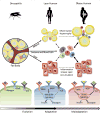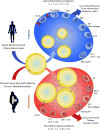Foundations of Immunometabolism and Implications for Metabolic Health and Disease
- PMID: 28930657
- PMCID: PMC5627521
- DOI: 10.1016/j.immuni.2017.08.009
Foundations of Immunometabolism and Implications for Metabolic Health and Disease
Abstract
Highly ordered interactions between immune and metabolic responses are evolutionarily conserved and paramount for tissue and organismal health. Disruption of these interactions underlies the emergence of many pathologies, particularly chronic non-communicable diseases such as obesity and diabetes. Here, we examine decades of research identifying the complex immunometabolic signaling networks and the cellular and molecular events that occur in the setting of altered nutrient and energy exposures and offer a historical perspective. Furthermore, we describe recent advances such as the discovery that a broad complement of immune cells play a role in immunometabolism and the emerging evidence that nutrients and metabolites modulate inflammatory pathways. Lastly, we discuss how this work may eventually lead to tangible therapeutic advancements to promote health.
Copyright © 2017 Elsevier Inc. All rights reserved.
Figures



References
-
- Aguirre V, Werner ED, Giraud J, Lee YH, Shoelson SE, White MF. Phosphorylation of Ser307 in Insulin Receptor Substrate-1 Blocks Interactions with the Insulin Receptor and Inhibits Insulin Action. J Biol Chem. 2002;277:1531–1537. - PubMed
-
- Arkan MC, Hevener AL, Greten FR, Maeda S, Li ZW, Long JM, Wynshaw-Boris A, Poli G, Olefsky J, Karin M. Ikk-Beta Links Inflammation to Obesity-Induced Insulin Resistance. Nature medicine. 2005;11:191–198. - PubMed
-
- Ballak DB, Stienstra R, Hijmans A, Joosten LA, Netea MG, Tack CJ. Combined B- and T-Cell Deficiency Does Not Protect against Obesity-Induced Glucose Intolerance and Inflammation. Cytokine. 2013;62:96–103. - PubMed
-
- Barnes PJ, Karin M. Nuclear Factor-Kappab: A Pivotal Transcription Factor in Chronic Inflammatory Diseases. The New England journal of medicine. 1997;336:1066–1071. - PubMed
Publication types
MeSH terms
Substances
Grants and funding
LinkOut - more resources
Full Text Sources
Other Literature Sources
Medical

